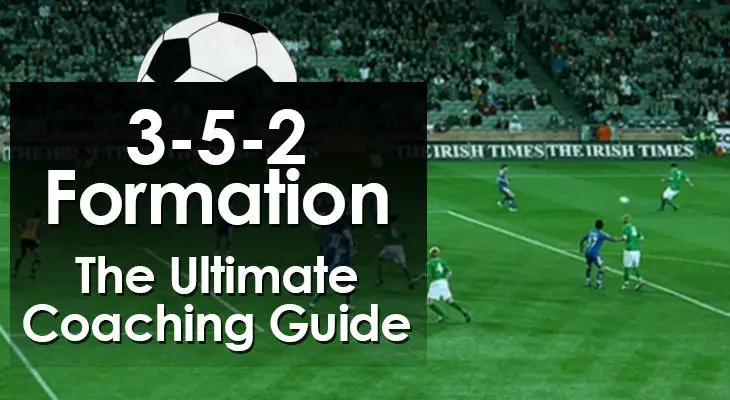3-5-2 Formation – The Ultimate Coaching Guide
Attacking penetration, defensive solidity, and possession control…these are all trademarks of a team playing in a 3-5-2 formation.
For the right team, with the right players, the 3-5-2 can prove deadly against any opponent.
The midfield offers flexibility and can be adapted to the opposition, whether you want to be defensively sound or more threatening in attack.
Success in the 3-5-2 formation often relies on having talented and fit wingbacks who pace up and down either sideline for the entire game.
Providing both attacking and defensive width, getting the right individuals for these roles is key.
With three center backs and two strikers, the shape doesn’t lack firepower and won’t leave you outnumbered in defense.
That said, it may take time for players to adapt.
Below, I take you through the 3-5-2 in detail, outlining its strengths and weaknesses, before arming you with the tactical knowledge you need to set up your team for success.
Let’s go!
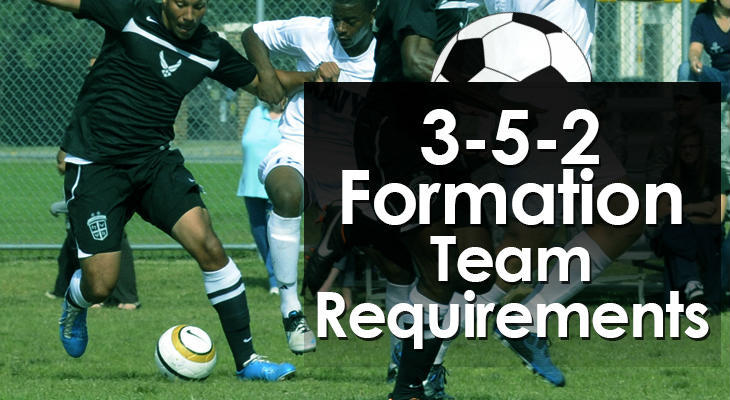
What is a 3-5-2 Formation?
The 3-5-2 formation rose to prominence in the 1986 World Cup when Argentina’s coach led his team to glory in the shape.
His idea was to create central dominance and defensive stability while leaving space for the talismanic Diego Maradona to exploit in the attacking areas.
It’s a very balanced formation, especially if you have different styles of midfielders in your squad.
The Defense and Wingbacks
The flat-back three work as a unit and can be deployed as a low block or a high line with a sweeper in the middle.
Right and left wingbacks are responsible for defending the wide areas and providing width in attack.
They operate slightly ahead of the center backs and ultimately form part of the midfield.
In many instances, the quality of your wingbacks makes or breaks this formation.
Center Midfielders
The center midfield trio is also integral to how your team will function in this shape and there are several ways to set them up.
Some coaches opt for a strong defensive midfielder (CDM) and two box-to-box type players.
Others prefer two CDMs as a defensive shield and one more attack-oriented midfielder.
Forwards
Up top, the team is spearheaded by two forwards who, again, can be set out in different ways.
For a dynamic attack, you can use dual strikers that constantly put the defense under pressure.
Or, like Argenitina’s triumphant 1986 World Cup team, you can play with one number 9 and one free-roaming attacker (Maradona).
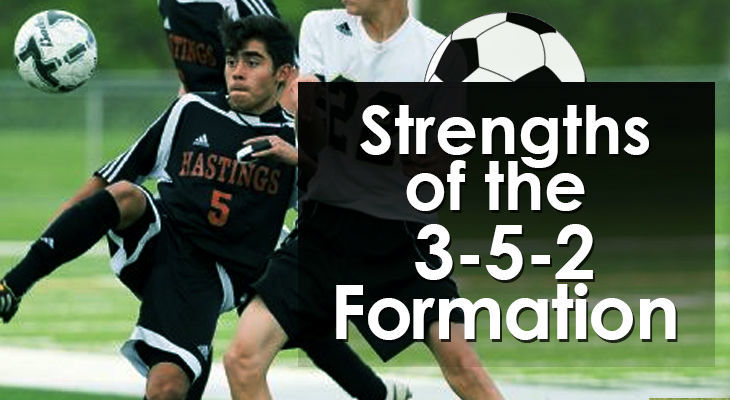
3-5-2 Formation Strengths
#1. Controlling Possession
The midfield trio with wingbacks on either side allows your team to dominate possession.
Your midfielders can methodically break down the opposition with neat passing triangles.
If your opponent decides to crowd out the midfield, your wingbacks will be in space out wide.
When attacking moves break down, there are always three center backs available to pass to and recycle possession.
The shape enables patient buildup play but the spacing also ensures you can be direct or attack on the counter.
#2. Strong Defense
There’s a reason many modern teams are now using three-player backlines.
Unless your opponent goes gung-ho with four attackers, you’ll virtually always have a numerical advantage in defense.
When defending a lead, the wingbacks can drop in to form a back five, giving further stability.
In most 3-5-2 formations, you’ll have at least one CDM to provide cover and cut out passing lines to the forwards, making central attacks very difficult for opponents.
#3. Double Trouble Up Front
Two strikers are every modern center back’s nightmare.
In most modern formations, teams use one center forward and two wingers.
While this causes a whole other problem for defenses, the center backs are generally in control of their area.
Dual strikers give more attacking options and ensure you always have targets in the box.
Furthermore, you can resort to route one tactics if you’re struggling to build attacks methodically.
#4. Shape Flexibility with Wingbacks
Wingbacks give this formation enormous flexibility.
If your team is dominating possession, the wingbacks can hold advanced positions for sustained periods, stretching the opposition defense.
Alternatively, when your team’s back is against the wall, the wingbacks can drop back to create a deep bank of five defenders.
However, in most games, your wingbacks will have to read the ebbs and flows of the contest and choose their moments to impact the game.
#5. Midfield Fluidity
Three-player midfields dominate the modern game, and for good reason.
They allow your team to attack and defend with fluidity.
While each player has their individual role, they can interchange and take up different positions without leaving gaping holes in the defense.
Since smooth ball progression is all about passing triangles, the trio is a perfect combination.
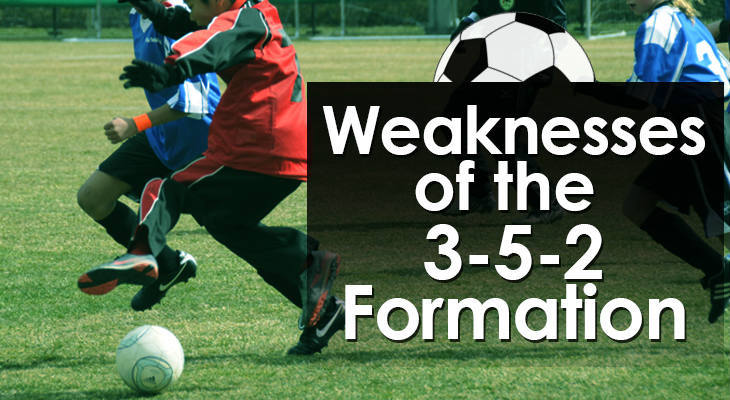
3-5-2 Formation Weaknesses
#1. Midfield Congestion
On paper, it might seem that this formation is void of weaknesses, especially through the center.
However, with a trio of midfielders and a three-player backline, the middle of the park can get congested.
In particular, the midfielders must work in harmony and understand spacing.
Otherwise, they’ll likely turn the ball over, leading to dangerous transition play.
#2. Vulnerable on the Wings
Naturally, the central focus of the 3-5-2 formation means the main vulnerabilities lie on the wings.
The open spaces along the flanks become especially apparent when the wingbacks get caught in advanced positions.
A sloppy turnover can leave the wings wide open to counterattacks.
While a midfielder or center back can cover the flanks, this stretches your team and leaves potential openings.
#3. Requires Quality Center Backs
You might think that three centerbacks allow you to compensate for a lack of talented defenders.
This is not the case.
Although the outside center backs can step out of the line occasionally, they must hold their positions more often than not.
In order to cover for one another, each defender must understand the system perfectly and adhere to it religiously.
Moreover, a three-player backline often invites pressure from the opposition so each defender must be defensively savvy and capable of holding their own.
Center back trios are also important for ball retention so they’re required to be comfortable in possession and technically sound.
#4. Relies on Uber Fit Wingbacks
With sole responsibility for wide play, the wingbacks have a lot to do.
Even in games where your team is performing well, tracking up and down the field for 90 minutes is extremely taxing.
Therefore, your wingbacks must be extremely fit.
They’re not only required to cover immense ground, but they’re also relied upon in key defensive scenarios and attacking sequences.
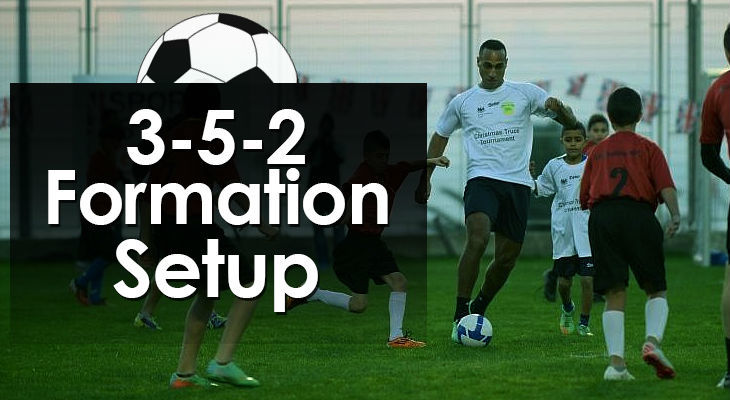
How to Play the 3-5-2 Formation
The 3-5-2 formation isn’t overly complicated.
That said, we don’t always see three center backs, a packed midfield, and an attacking duo in the modern game.
So, to ensure your players are up to the task, let’s take a closer look at how to approach the formation tactically.
3-5-2 Formation Setup
One of the joys of this setup is that the starting positions are easy to digest.
There are three core banks of players, but bear in mind that the midfielders, wingbacks, and forwards may drop into the half-spaces (spaces between the core banks).
Three center backs
Three center midfielders flanked by two wingbacks
Two strikers
Here’s how it looks on the field:
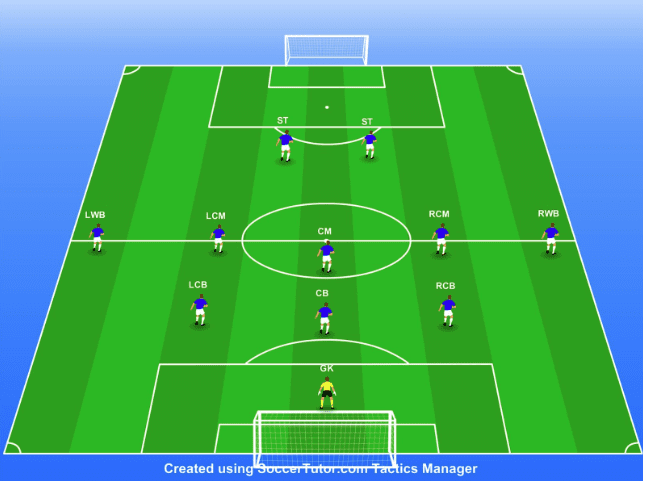
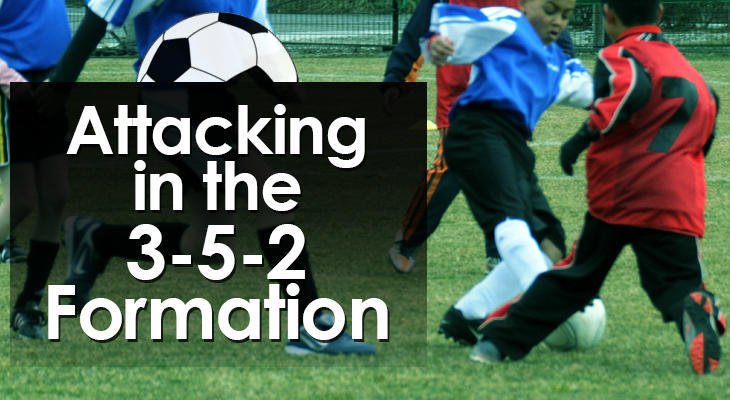
Attacking in the 3-5-2 Formation
The 3-5-2 is tactically flexible.
With a packed midfield and three center backs, you can invite pressure and spring on the counterattack.
However, if you want to seize the initiative and make the most of this shape, there are certain things you should focus on.
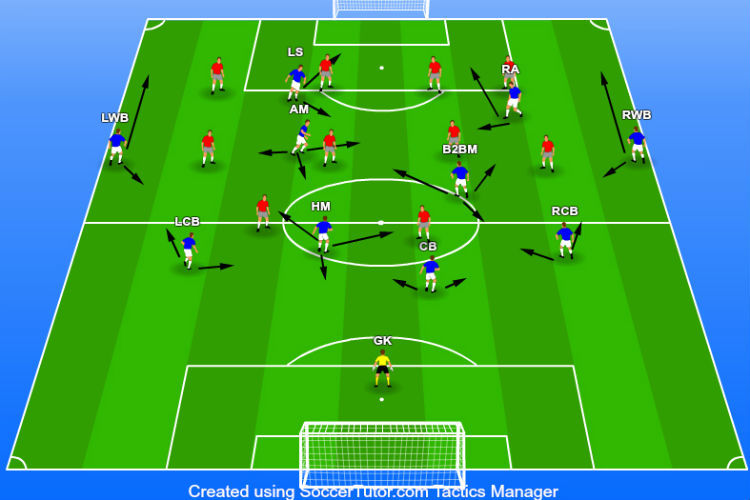
1. Wear Down Opponents with Possession
The spacing of the 3-5-2 formation allows your team to create overloads all over the field.
Centrally, the trio of midfielders can use triangles to progress the ball through the middle.
They can also drift wide and link up with the wing-backs.
With dual strikers, there are always forward passing options, whether they run into the channels or come short to receive possession.
The three center backs are passing outlets and relief options for all players.
Be sure to take advantage of your numerical advantages by moving the ball across the field and gradually wearing down your opponents.
2. Use the Wingbacks
With any formation, it’s important not to be predictable.
Don’t force things through the middle if your opposition shut down central channels.
Draw in defenders then spread the ball wide to your wingbacks to open up the space.
From here, it’s up to the wingbacks to execute.
3. Feed and Support the Strikers
There’s no point in having dual strikers if you don’t use them.
Instruct your midfielders to play line-breaking passes to the strikers.
Since there are two of them, they’re likely to be in a 1v1 situation which allows them to create.
However, it’s also important to provide support to the strikers, with penetrating runs from midfield and well-timed movements along the wings.
This not only creates more space, but it also forces the opposition to move and make decisions.
4. Sustain Attacks with a High Line
High lines don’t suit all teams.
But, if at all possible, push your defenders forward when you’re in possession.
With minimal gaps between your core lines (defense, midfield, and attack), you can recycle possession and sustain attacks for longer.
Just be wary of fast strikers playing on the shoulders of your defenders.
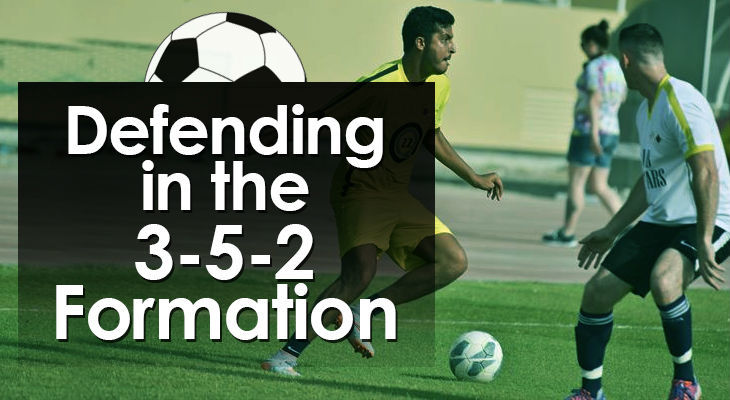
Defending in the 3-5-2 Formation
In the 3-5-2, you can easily pull numbers back to solidify your defense.
Most coaches who use this formation, do so for its defensive prowess.
Here are some key factors to consider when devising your defensive tactics in the 3-5-2 formation.
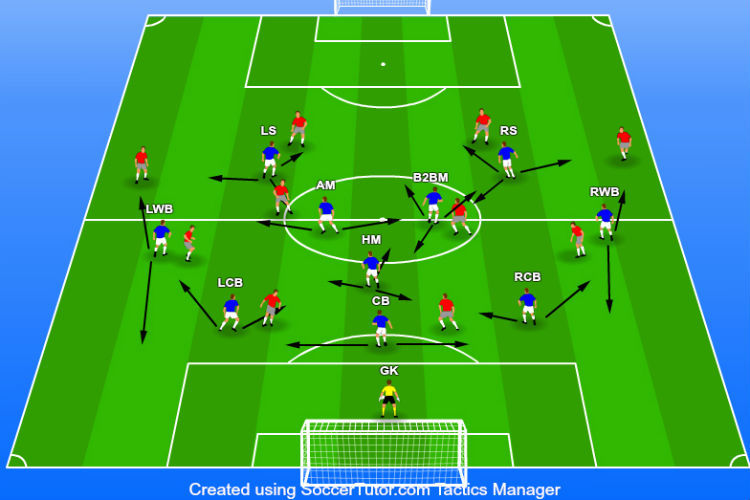
1. Form a Mid Block with the Midfield
Regardless of how you set up your midfield, when your team is out of possession, a mid-block is an extremely effective way to limit your opponent’s offense.
A mid-block essentially means pulling your midfielders back behind the ball but in front of the backline.
This cuts off passing lanes and prevents central penetration.
Each midfielder protects their own zone and presses the ball when it comes into their area.
2. Be Wary of the Back Post
As mentioned, the wings are particularly vulnerable in this shape.
Your opponents are likely to know this and will target the back posts with crosses and passes.
While your wingbacks should join attacks, make sure they’re aware of their defensive responsibilities.
When the ball gets turned over, their main focus should be to defend the back post and track any late runners into the box.
3. Press From the Front
Another advantage of having two strikers is that they allow you to press high up the field.
Although your players might not be capable of all-out gegenpressing, two forwards applying pressure to on-the-ball defenders can be extremely effective.
Even if they don’t win the ball back, they can force the defenders into long balls, increasing your chances of winning possession.
4. Communicate and Cover
The defensive ethos of your team should be “communicate and cover”.
With congested central areas and space along the wings, your players must be in sync to limit the opposition’s attack.
If one player steps out of position, another should fill their place.
Communication and cover habits are built on the training field so make sure your sessions are loud and full of chatter.
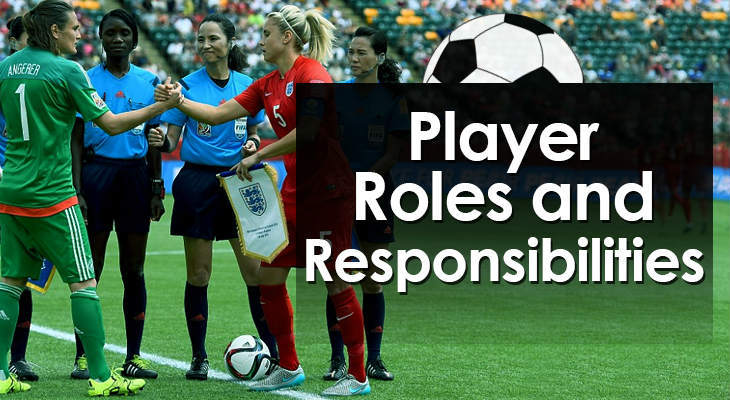
Individual Position Responsibilities
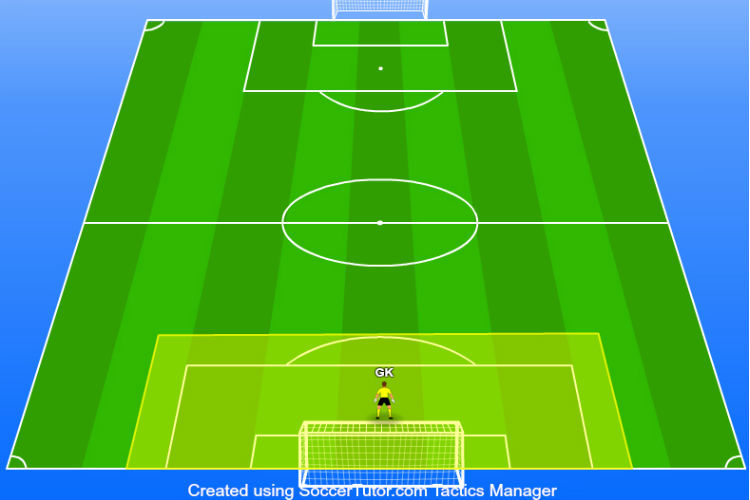
Goalkeeper
A 3-5-2 formation usually indicates that the team prefers a possession-based style.
So, rather than choosing a goalie that specializes in shot-stopping and 1v1s, you may be better off with one that’s comfortable with the ball at their feet.
The goalkeeper can then serve as an extra passing option during buildup phases.
Since your opponents are likely to focus on wide attacks, your goalie should also be competent at dealing with crosses.
A safe pair of hands and good timing for punches are key.
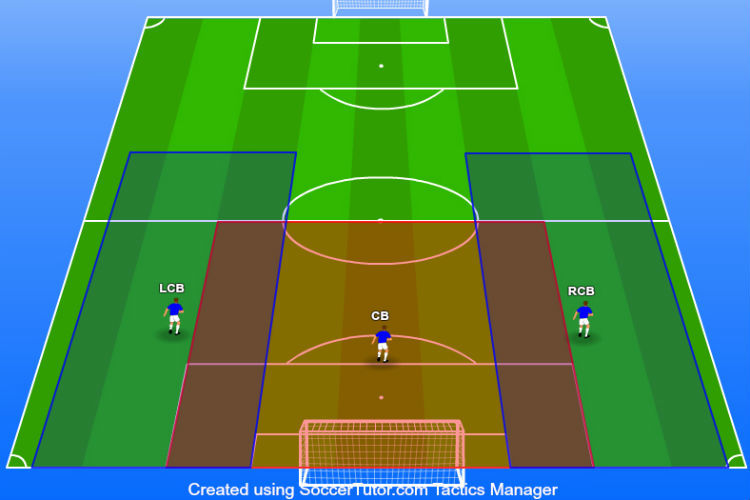
Center Backs
The three center backs form a stern backline that protects the path to goal at all costs.
Communication and cover must be etched into their minds.
If one defender steps out to engage an opponent, the other two must provide appropriate cover for them and watch out for runners in behind.
Occasionally, the center backs need to leave their central post and provide cover for their wingbacks.
Again, they should communicate and shift positions toward the ball to plug any gaps.
These moments are when your defense is most vulnerable.
So, when things go a little pear-shaped, each center back should be able to rely on their defensive technique and 1v1 defending.
A three-player backline will also deal with a lot of crosses so make sure you choose center backs who are dominant in the air.
Finally, in the modern game, defenders are not just required to defend; they must also be comfortable on the ball and help the team to retain possession.
Technically proficient center backs will help you dominate possession and slowly wear away at teams.
The best defenses are built on good positioning, communication, and teamwork.
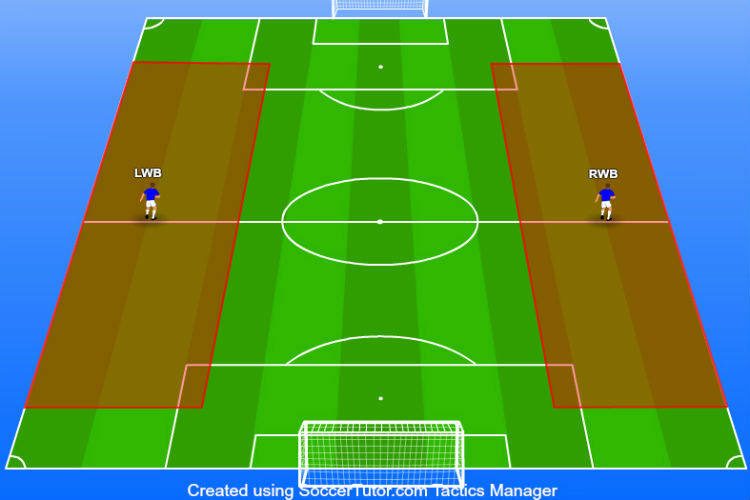
Wingbacks
The strengths of the 3-5-2 formation (possession, attacking options, and defensive stability) all derive from the wingback position.
Without them, the formation becomes too reliant on central dominance.
The ideal wingback is supremely fit, fast, and a good dribbler with a decent delivery.
On top of that, they need to be tactically disciplined to help out in both attack and defense when required.
A lot is asked of them so it is becoming an increasingly specialized position that is perfect for an all-rounder.
They must know when to stay wide and when to retreat and cover the back post.
In attack, they should look to combine with the central midfielders and get in behind the opposition’s defense to put crosses into the box.
They must be up and down the pitch constantly, providing passing angles and options for the central midfielders.
Their movement is what gives the midfielders space and time to operate in the center.
If they are ill-disciplined and constantly stay forward, the opposition may overload and overrun the areas behind them.
As mentioned earlier, it is in the centre midfield of the 3-5-2 formation that the coach can really stamp their identity and game plan on the team.
While the centrebacks stubbornly defend the goal and the superhuman wingbacks provide width and movement, it is the midfielders who dictate and control the game.
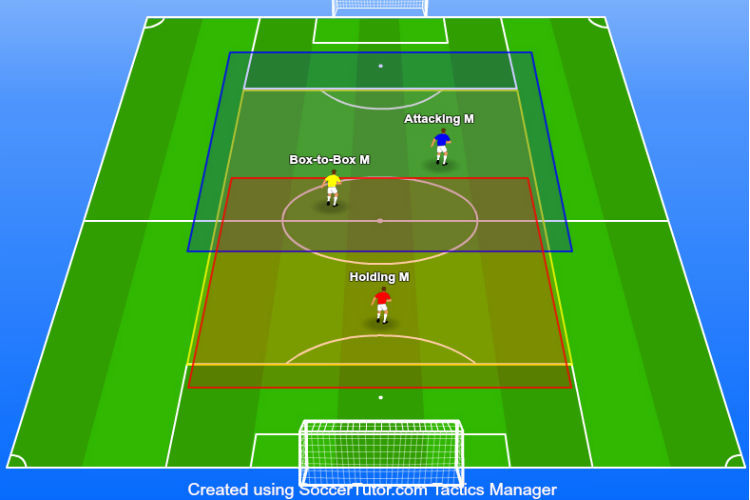
Midfield Trio
There are two main ways to set up your midfield in a 3-5-2 formation:
One defensive midfielder with two box-to-box midfielders
Two defensive midfielders and one attacking midfielder
When playing with one CDM, this player’s primary responsibilities are defensive.
They must sniff out danger and drop into defense when gaps appear.
The CDM should have great positional sense and a high work rate to close down, tackle, and mark the opposition’s players who are running into space.
Although the three center backs are the rock at the back, the CDM makes the 3-5-2 such an attractive option for attack-minded coaches who do not want to sacrifice a defender for an extra midfielder.
This CDM often drops deep to pick up the ball from the center backs so good ball-playing skills are necessary.
The box-to-box players do a little bit of everything and get forward when the opportunity arises.
When playing with two CDMs, the backline is extremely secure.
However, at least one of these players should also be capable of dictating play from deep.
The third midfielder is usually instructed to remain high up the field, create chances, and link play with the forwards.
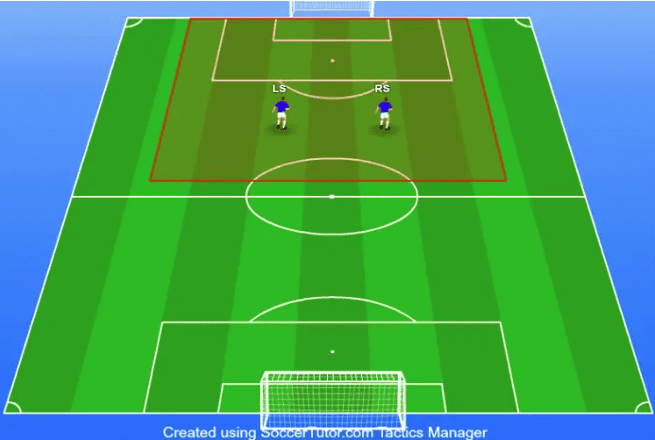
Dual Strikers
Much like the center backs and midfield unit, the strikers have to play together.
They should understand each other’s tendencies, movement patterns, and favorite positions.
This helps ensure they don’t get in one another’s way and makes chance creation more fluid.
Clever movement is essential to keep the defenders occupied and to find space from which to create.
If one striker drops deep to receive the other ball, the other should be making a run into the space behind them or looking for a spot to link the play.
Having one “target man” and one more mobile-type striker is a deadly mix as it provides your team with plenty of looks going forward.
When the ball goes wide, both players should be looking for the ball in the box and getting into dangerous positions.
As mentioned earlier, In a 3-5-2 formation the strikers are the first line of defense.
Pressing from the front is a great way to create high-percentage goalscoring opportunities.
How to Beat a 3-5-2 Formation
Beating a well-balanced shape like a 3-5-2 isn’t easy.
However, there are proven ways to succeed against this type of formation.
1. Target the Wings
The most obvious weakness in the 3-5-2 is the wings.
If the wingbacks are getting forward constantly, keep two wingers forward at all times.
This will either give you space to counter or force the wingbacks to retreat, limiting the opponent’s attacking options.
A 4-2-3-1 can be an effective counter formation as it’s defensively sound with robust attackers in wide areas.
To really exploit the space on the flanks, focus on smooth transitional play, getting the ball out wide quickly when you turn the ball over.
2. Low Block and Counter
Another effective way to beat a 3-5-2 is to form a low block with physical center backs and defensive-minded midfielders.
The idea is to allow your opponents to keep possession but limit their touches in your penalty area.
As they commit more players forward, set up your team to counter-attack ruthlessly.
You should also work on set pieces to take full advantage of any attacking positions you get yourself into.
However, it’s important to note that this is a risky option as a single mistake can cost your team dearly.
3. Mirror
If you can’t beat them, join them.
Mirroring the 3-5-2 essentially diminishes the advantages that your opposition has.
So, if your team is capable of it, consider setting them up in the same formation and match up player for player.
Beating a well-balanced shape like a 3-5-2 isn’t easy.
However, there are proven ways to succeed against this type of formation.
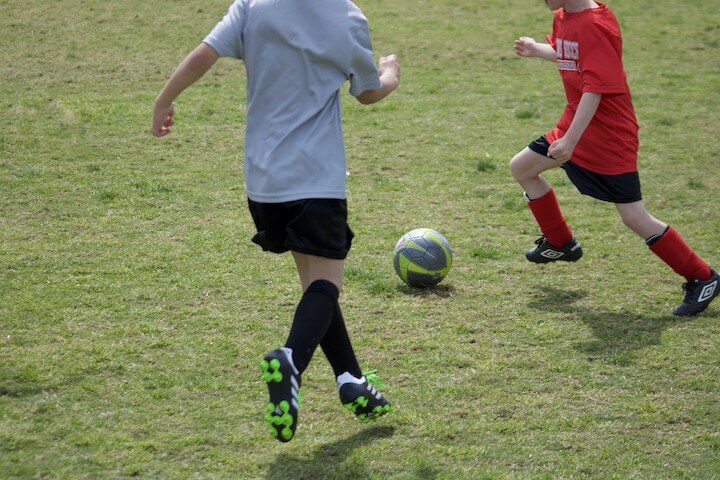
Conclusion
The 3-5-2 is a balanced formation that has more strengths than weaknesses.
However, if you don’t have the right players to fill the wingback and midfield roles, you’re likely to struggle.
The shape relies on specialist players in key positions and works best with possession-based tactics.
If your team isn’t ready to adjust to this shape right now, work on it throughout the season and slowly introduce the key principles.
It could be the perfect formation to grow into, especially with young players.

